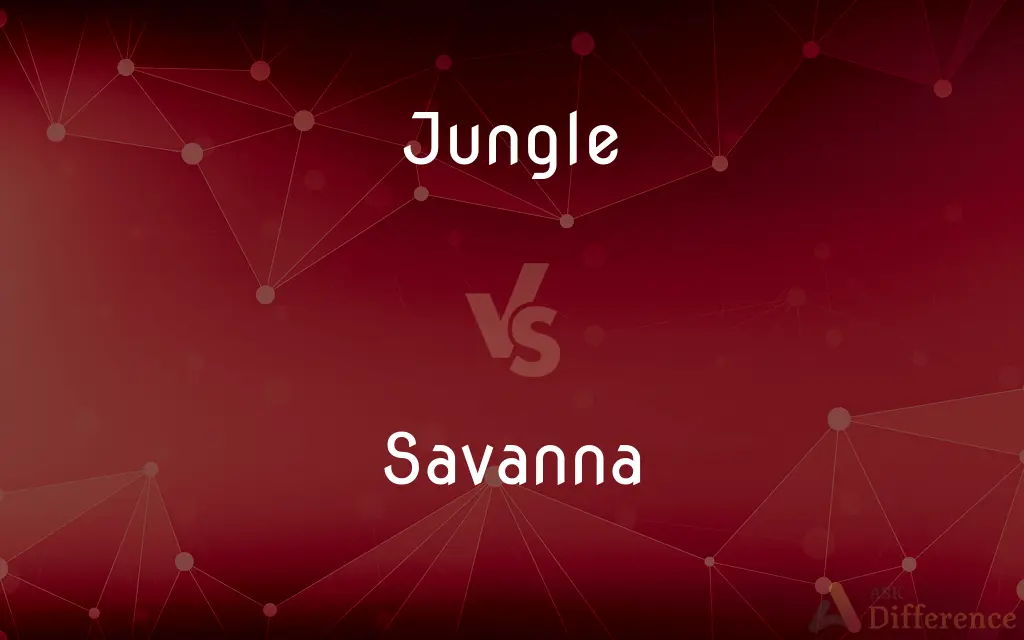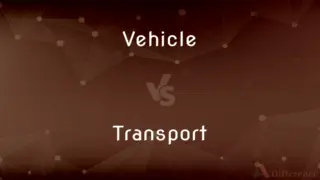Jungle vs. Savanna — What's the Difference?
By Tayyaba Rehman — Updated on August 25, 2023
A jungle is a dense, tropical rainforest with thick undergrowth, while a savanna is a grassy plain with scattered trees, often found in tropical and subtropical regions.

Difference Between Jungle and Savanna
Table of Contents
ADVERTISEMENT
Key Differences
A jungle is characterized by its dense and tangled vegetation, which can create a humid and dark environment due to the overlapping canopy. Savannas, on the other hand, are more open, primarily consisting of grasses with sporadic trees that allow sunlight to penetrate and touch the ground.
While both jungles and savannas can be found in tropical regions, their precipitation patterns differ drastically. Jungles receive consistent and abundant rainfall year-round, ensuring their lushness. Savannas, however, have distinct wet and dry seasons, leading to periods of growth and dormancy.
The flora of jungles typically includes tall trees, vines, and various shrubs, which together form multiple layers of vegetation. In contrast, the savanna's flora is dominated by grasses with trees like acacias and baobabs making occasional appearances.
Wildlife in jungles is diverse, with many species adapted to life in the tree canopy or the forest floor's dense undergrowth. In savannas, the wildlife, such as lions, elephants, and zebras, is adapted to the open landscape and the seasonal availability of resources.
Both ecosystems play vital roles in our planet's biodiversity. While jungles act as the lungs of the Earth, absorbing carbon dioxide, savannas support large populations of herbivores and their predators.
ADVERTISEMENT
Comparison Chart
Vegetation Density
Dense and tangled
Open, primarily grassy
Rainfall Pattern
Consistent, heavy rainfall
Seasonal with distinct wet and dry periods
Flora
Tall trees, vines, shrubs
Grasses with scattered trees like acacias
Wildlife Adaptation
Adapted to dense undergrowth
Adapted to open landscapes and seasonal resources
Role in Biodiversity
Acts as Earth's lungs
Supports large populations of herbivores
Compare with Definitions
Jungle
A jungle is a dense tropical forest.
They trekked through the jungle to reach the ancient ruins.
Savanna
A savanna is a grassy plain with sparse trees.
Elephants roamed freely across the vast savanna.
Jungle
Jungles have a multi-layered vegetation structure.
Birds flitted through the different layers of the jungle.
Savanna
A savanna or savannah is a mixed woodland-grassland ecosystem characterised by the trees being sufficiently widely spaced so that the canopy does not close. The open canopy allows sufficient light to reach the ground to support an unbroken herbaceous layer consisting primarily of grasses.Savannas maintain an open canopy despite a high tree density.
Jungle
It's often characterized by heavy rainfall.
The jungle's foliage was lush due to the frequent rains.
Savanna
Savannas have distinct wet and dry seasons.
The savanna turned green during the wet season.
Jungle
Jungles are rich in biodiversity.
Scientists discovered a new species of frog in the jungle.
Savanna
They are often found in tropical and subtropical regions.
The African savanna is known for its iconic wildlife.
Jungle
A jungle is land covered with dense forest and tangled vegetation, usually in tropical climates. Application of the term has varied greatly during the past recent centuries.
Savanna
Fire is a common and natural occurrence in savannas.
A fire swept through the savanna, rejuvenating the grasslands.
Jungle
(South Asia) Any uncultivated tract of forest or scrub habitat.
Savanna
A flat grassland in tropical or subtropical regions
Jungle
A desert region.
Savanna
A grassland with scattered tree growth, especially in a tropical or subtropical region.
Jungle
A location marked by an intense competition and struggle for survival
Savanna
A tropical grassland with scattered trees
Jungle
Land covered with a dense growth of tropical vegetation.
Savanna
A tract of level land covered with the vegetable growth usually found in a damp soil and warm climate, - as grass or reeds, - but destitute of trees.
Savannahs are clear pieces of land without woods.
Jungle
A dense thicket or growth.
Savanna
Savannas support diverse herbivore populations.
Zebras and antelopes grazed side by side on the savanna.
Jungle
A dense, confused mass; a jumble.
Jungle
Something made up of many confused elements; a bewildering complex or maze
Sorting through the jungle of regulations.
Jungle
A place or milieu characterized by intense, often ruthless competition or struggle for survival
The corporate jungle.
Jungle
(Slang) A place where hoboes camp.
Jungle
A large, undeveloped, humid forest, especially in a tropical region, that is home to many wild plants and animals; a tropical rainforest.
Jungle
(colloquial) A place where people behave ruthlessly, unconstrained by law or morality.
It’s a jungle out there.
Jungle
(figurative) A tangled mess.
Jungle
(UK) A migrant camp.
Jungle
A style of electronic dance music and precursor of drum and bass.
Jungle
Dense rough.
Tiger country
Jungle
A hairy vulva.
Jungle
(Of musical beat, rhythm, etc.) resembling the fast-paced drumming of traditional peoples of the jungle.
Jungle
A dense growth of brushwood, grasses, reeds, vines, etc.; an almost impenetrable thicket of trees, canes, and reedy vegetation, as in India, Africa, Australia, and Brazil.
The jungles of India are of bamboos, canes, and other palms, very difficult to penetrate.
Jungle
A place of danger or ruthless competition for survival.
Jungle
Anything which causes confusion or difficulty due to intricacy; as, a jungle of environmental regulations.
Jungle
An impenetrable equatorial forest
Jungle
A place where hoboes camp
Jungle
The term can imply a wild, chaotic environment.
The city was a concrete jungle with its bustling streets.
Jungle
(slang) An area where hobos camp together.
Common Curiosities
What's the primary threat to jungles worldwide?
Deforestation, primarily for agriculture and logging, is a major threat.
Do fires harm savannas?
Fires are natural in savannas and can help rejuvenate the ecosystem by clearing old vegetation.
Can savannas be found outside Africa?
Yes, savannas are also present in regions of South America, Australia, and South Asia.
Are savannas always hot?
While savannas are typically warm, temperatures can vary based on the region and season.
What are some iconic animals of the savanna?
Lions, elephants, zebras, and giraffes are among the iconic animals of the savanna.
Why are jungles so important for the environment?
Jungles act as carbon sinks, help regulate climate, and support immense biodiversity.
Is the Amazon a jungle?
Yes, the Amazon encompasses vast jungles within its rainforest expanse.
Can humans live sustainably in jungles?
Indigenous communities have lived in jungles for centuries, using sustainable practices.
Are all savannas flat landscapes?
While many savannas are flat plains, they can also have undulating terrains and scattered hills.
Do jungles and rainforests mean the same thing?
Not exactly. While all jungles are rainforests, not all rainforests are jungles. Jungles specifically refer to the dense undergrowth of the rainforest.
Share Your Discovery

Previous Comparison
People vs. Public
Next Comparison
Vehicle vs. TransportAuthor Spotlight
Written by
Tayyaba RehmanTayyaba Rehman is a distinguished writer, currently serving as a primary contributor to askdifference.com. As a researcher in semantics and etymology, Tayyaba's passion for the complexity of languages and their distinctions has found a perfect home on the platform. Tayyaba delves into the intricacies of language, distinguishing between commonly confused words and phrases, thereby providing clarity for readers worldwide.
















































